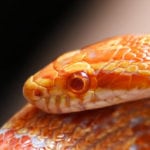 Music
Music  Music
Music  History
History 10 Less Than Jolly Events That Occurred on December 25
 Weird Stuff
Weird Stuff 10 Funny Ways That Researchers Overthink Christmas
 Politics
Politics 10 Political Scandals That Sent Crowds Into the Streets
 Weird Stuff
Weird Stuff Ten Bizarre Facts About The Doge Meme
 Our World
Our World 10 Ways Your Christmas Tree Is More Lit Than You Think
 Movies and TV
Movies and TV The 10 Coolest Stars to Set Sail on The Love Boat
 History
History 10 Things You Didn’t Know About the American National Anthem
 Technology
Technology Top 10 Everyday Tech Buzzwords That Hide a Darker Past
 Humans
Humans 10 Everyday Human Behaviors That Are Actually Survival Instincts
 Music
Music 10 Surprising Origin Stories of Your Favorite Holiday Songs
 History
History 10 Less Than Jolly Events That Occurred on December 25
 Weird Stuff
Weird Stuff 10 Funny Ways That Researchers Overthink Christmas
Who's Behind Listverse?

Jamie Frater
Head Editor
Jamie founded Listverse due to an insatiable desire to share fascinating, obscure, and bizarre facts. He has been a guest speaker on numerous national radio and television stations and is a five time published author.
More About Us Politics
Politics 10 Political Scandals That Sent Crowds Into the Streets
 Weird Stuff
Weird Stuff Ten Bizarre Facts About The Doge Meme
 Our World
Our World 10 Ways Your Christmas Tree Is More Lit Than You Think
 Movies and TV
Movies and TV The 10 Coolest Stars to Set Sail on The Love Boat
 History
History 10 Things You Didn’t Know About the American National Anthem
 Technology
Technology Top 10 Everyday Tech Buzzwords That Hide a Darker Past
 Humans
Humans 10 Everyday Human Behaviors That Are Actually Survival Instincts
10 Fascinatingly Bizarre Crustaceans
Everyone is pretty well acquainted with crustaceans: arthropods who dominate the seas as heavily as their insect sisters rule the land. But the familiar crabs, lobsters, and shrimp are only a few examples of this order’s vastness and incredibly varied diversity. Crustaceans can be found in virtually every aquatic environment on earth, from the freezing Arctic to hostile toxic springs, and include a dizzying array of predators, scavengers, herbivores, and parasites.
10 Gribbles

Trees don’t sound like the typical diet of an ocean dweller, but enough timber washes out to sea that several marine animals depend on it as a food source. Isopods of the family Limnoriidae are an example, having evolved to feed exclusively on submerged wood. They’re more commonly known as “gribbles,” an adorable name for something that could once doom a vessel. The little sea-termites are almost as destructive as the famous “shipworms.”
Gribbles have enjoyed a new surge of attention in recent months. An enzyme produced during their feeding process is exceptionally effective in turning wood into simple sugars—a process that could provide an efficient source of renewable biofuel if we could learn to replicate it.
9 Pea Crabs
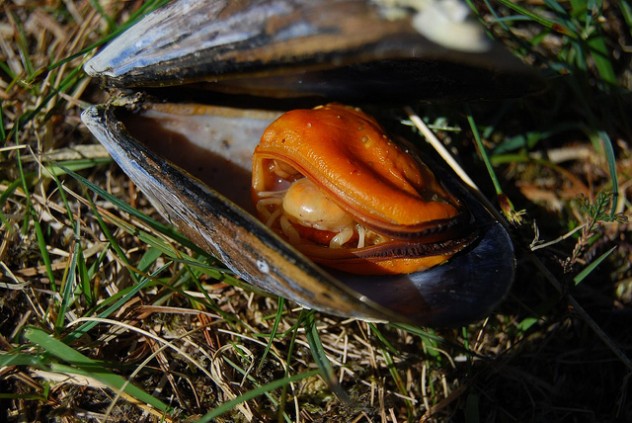
While certain human parasites are known as “crabs,” the only literal crabs to exhibit parasitism are the family Pinnotheridae. Tiny, soft-shelled, and delicate, these crabs spend their lives within the body cavities of clams, oysters, sea squirts, sea cucumbers, and several other creatures—where they consume a share of the food taken in by their host.
Pea crabs are as edible, and often find themselves accidentally steamed and served up in a clam. In some cases, they are deliberately harvested and prepared as their own dish.
8 Skeleton Shrimp
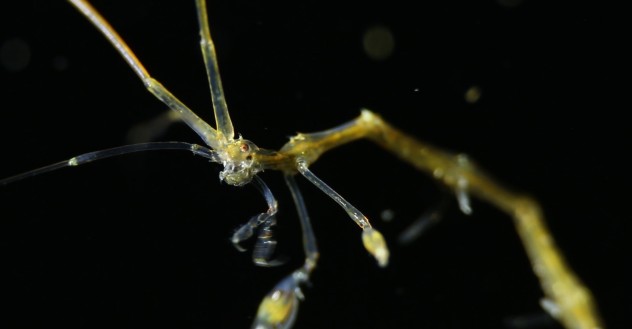
The Caprellidae are tiny marine predators that are often referred to as “skeleton shrimp” for their thin, ghostly form. With their hooked legs, they anchor themselves firmly to coral, sponges, seaweed, and an assortment of other surfaces. Then, they lie in ambush for their prey. Some species even live up to the exaggerated reputation of the mantis mating process. The females inject males with venom and consume them shortly after mating.
Skeleton shrimp are often transported to new ecosystems by human activity, and their numbers can become dense enough to completely carpet submerged surfaces like hungry, living velcro. Even large commercial fish can be devastated by these population explosions, as the bony bugs out-compete them for plankton and easily slaughter newly hatched fish fry.
7 Buoy Barnacles
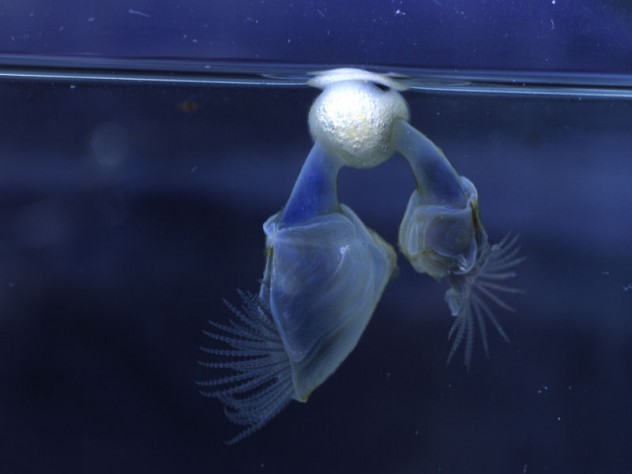
Once considered mollusks, it was Charles Darwin himself who first deduced that barnacles were, in fact, crustaceans. They simply traded mobility for an immobile, plankton-feeding lifestyle. Although, at least one species has returned to a form of mobility; the buoy barnacle is the only barnacle able to secrete its own spongy “float” if it can find no other suitable attachment point. In this case, it rides along the ocean’s currents like an exoskeletal Man O’ War.
These little surfers sometimes cluster together into communal rafts, which in turn can become home to other barnacle species.
6 Remipedes
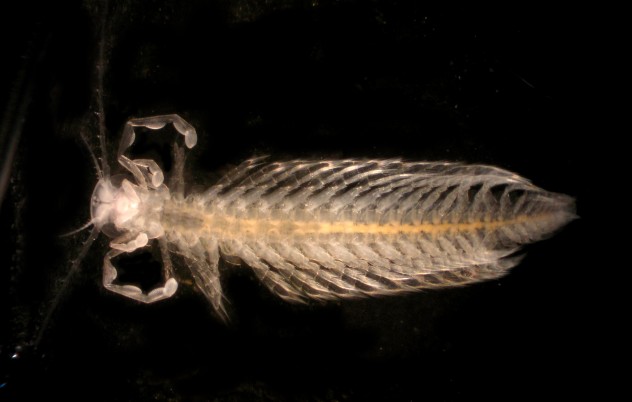
With long, segmented bodies and dozens of paddling limbs, remipedes look just like swimming centipedes. They even possess a large set of “fangs,” which are speculated to deliver venom. Study of these elusive creatures isn’t easy, as they live deep underground in submarine caverns and saltwater aquifers. Their worldwide distribution suggests that this wasn’t always the case, but evolutionary competition likely drove these once common animals into their dark recesses millions of years ago.
In honor of their monstrous appearance, a recently identified Remipede family has been dubbed the “Godzilliidae,” including the subfamilies Godzilliognomus, Godzillius, and Pleomothra.
5 Whale Lice
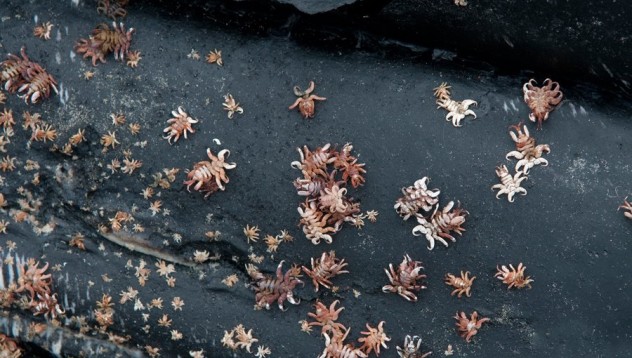
“Whale lice,” or cyamids, are the largest known arthropods that spend their entire lives on the body of a mammal. They cling to wrinkles, scar tissue, and barnacles on the surfaces of whales and porpoises. It sounds unpleasant, but the little creatures only feed upon dead skin and algae, causing no harm to their hosts. They are even responsible for the most distinctive feature of the Eubalaena genus of whales; the unique white patches on these animals are formed by tens of thousands of pale lice, clinging to the whale.
Interestingly enough, Cyamids also happen to be a subgroup of the Caprellidae or “skeleton shrimp” we talked about earlier, having lost their carnivorous habits as they adapted to the bodies of whales.
4 Pistol Shrimp
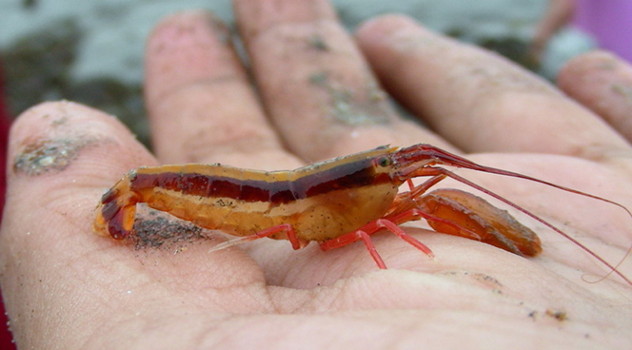
The Alpheidae, or pistol shrimp, are best known for their astounding organic weaponry; by snapping their one enlarged claw, they produce a collapsing cavitation bubble capable of paralyzing or killing small fish with its intense burst of sound and pressure.
Impressive as their biological stun guns may be, they aren’t the only thing that sets pistol shrimp apart. A few species are the only crustaceans known to live in eusocial colonies—like ants or termites, with specialized reproductive “queens” and non-reproductive working castes. They live and feed entirely within sea sponges, keeping them clear of harmful parasites in the process. They’re the bees of the sea, with supersonic stings and symbiotic hives.
3 Anchor Worms
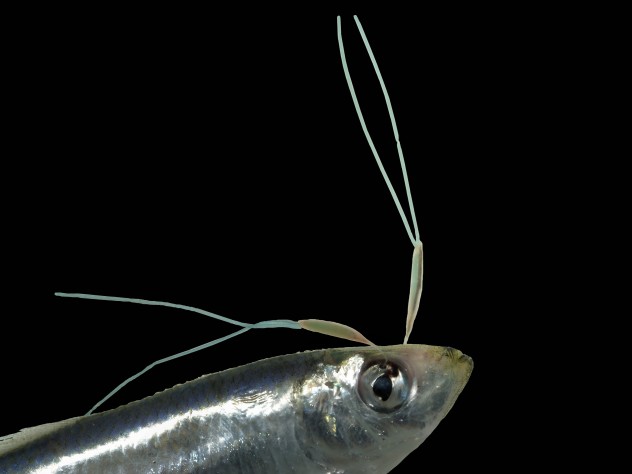
A number of copepod crustacean families share the common name “anchor worm,” which should be your first hint that we’re dealing with some serious oddballs. At maturity, these parasites lose any resemblance to an arthropod. They molt into blind and limbless tubes of tissue. They can be found attached to fish or even their fellow invertebrates.
Some anchor worms are bloodsuckers. They send “roots” deeper into the host’s body and turn a brilliant red. Some more horrific varieties embed themselves in the eyeballs of fish and consume vitreous jelly. A few bizarre species have a mouth on the end of a flexible, elephant-like trunk, which is held outside the host’s body to steadily graze. These sweep over the same small patch of the host for their entire lives.
Perhaps the most disturbing anchor worm is Trebius shiinoi, which can be found inside the uterus of female angel sharks. In many cases, they spread to a pregnant host’s unborn pups.
2 Pram Bug
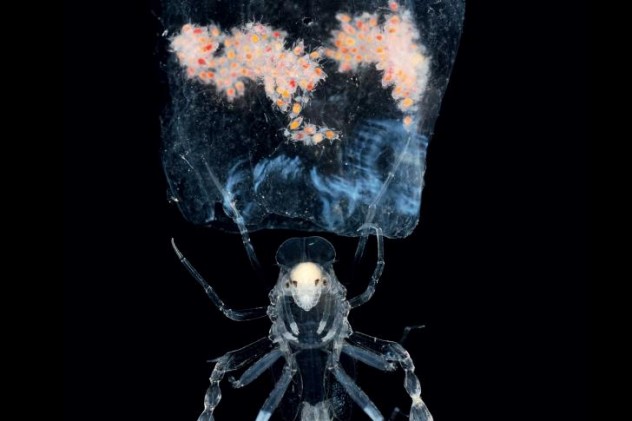
Pram bugs are a group of deep-sea hunters that are often compared to the movie “Alien,” both for their eerily elongated heads and their gruesome lifestyle. When the time comes to rear her young, the female will hunt down a gelatinous filter-feeder (distantly related to us vertebrate) and carve its body into a hollow tube. She employs this mutilated corpse as a mobile nursery, using her many paddles to steer it through the water and keep her eggs oxygenated. She will regularly pull prey inside the body with her, tearing it apart so her young can share the meal.
1 A Parasite’s Parasites

The parasitic barnacle, Sacculina, has been featured in Listverse articles before, but we’ll need to recap before we really talk about our next crustacean. Sacculina is barely identifiable as an animal in its mature form. I was even misidentified as a fungus in early texts. After discarding 90% of her body, the female grows as little more than a webbing of tissue throughout her crab host, which is castrated and duped into raising the parasite’s eggs. If the host happens to be male, Sacculina will manipulate its hormone levels until it thinks and acts like a mother.
Before it can pull of this changeling routine, the Sacculina needs to find a mate of her own. When she is finished growing, she develops a large sack of tissue on the outside of the crab’s body, called an externa. Tiny, larval males of her species will inject themselves into this exposed blob, fertilizing her from within for the remainder of their lives.
Unfortunately, the Externa leaves the Sacculina exposed to more than just her own kind; Liriopsis pygmaea is a parasitic isopod that lives exclusively on the external sacs of parasitic barnacles: a parasite on a parasite, or what biologists call a “hyperparasite.”
Just like its host, the isopod will lose most of its identifying features as it matures, becoming nothing but a white, fleshy pearl. And just as the barnacle castrated the crab, these spherical lice render the barnacle sterile as well.
Jonathan Wojcik is a web cartoonist and amateur biologist born on Halloween. You can find more of his writing on Cracked and his own website, Bogleech.com







